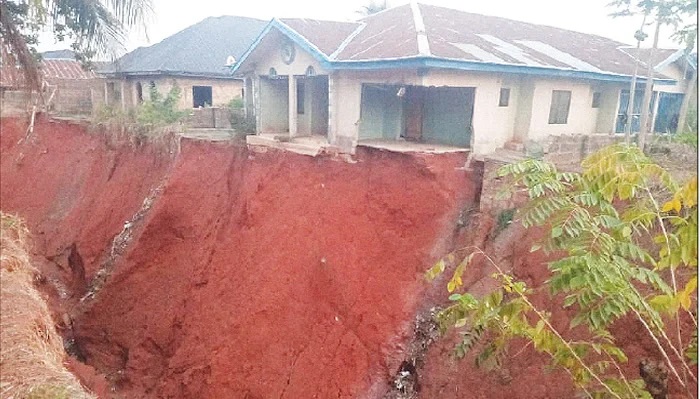General
Delta Got 988% More Revenue Than Osun in H1 2018—NEITI

By Modupe Gbadeyanka
A total of N3.95 trillion was shared among the federal, states and local government areas of the federation in the first half of 2018 from the Federation Account.
A statement from the Nigeria Extractive Industries Transparency Initiative (NEITI) signed by its Director of Communications and Advocacy, Dr Orji Ogbonnaya Orji, disclosed that the disbursements made by the Federation Accounts Allocation Committee (FAAC) represented an increase of 41 percent when compared to the N2.79 trillion disbursed in the first half of 2017 and a 95 percent increase in the N2 trillion disbursed in the first half of 2016.
According to the latest edition of the NEITI Quarterly Review, a breakdown of the disbursements showed that the federal government received N1.65 trillion, states received N1.38 trillion while local governments got the least share of N795 billion during the period under review.
The disparity in the revenues received by each of the three tiers of government was based on the revenue sharing formula of the federation as stipulated in the constitution.
The NEITI Quarterly Review shows that the lowest monthly figure of N635.6 billion disbursed in the first half of 2018 was N121.4 billion higher than the highest monthly figure (N514.2 billion) disbursed in the first half of 2017 and N218 billion higher than the highest monthly figure (N417 billion) for 2016.
“These figures clearly indicate that revenue accruing to the Federation in the first half of 2018 completely outstripped revenues in the previous two years,” stated the report.
The Quarterly Review further disclosed that total FAAC disbursements in the second quarter of this year was 46 percent higher than the figure for the same period last year and 127 percent higher than the figure for the same period in 2016.
The report noted that while N2 trillion was shared in the second quarter of this year, N1.38 trillion was disbursed during the same period last year and only N886.38 billion was shared in the second quarter of 2016.
“In fact, Q2, 2018 was the first time an amount in excess of N2trillion was disbursed since Q3 2014. This is a run of 14 consecutive quarters of disbursements below N2trillion,” it said.
The phenomenal increase of disbursements recorded in the second quarter of 2018, the report observed, was the highest to the Federation since the third quarter of 2014.
The report attributed the positive development to the rise in crude oil prices and similar increase in oil production.
“Average oil price in 2016 was $43.5 per barrel, while in 2017 oil price averaged $54.2 per barrel. However, in the first six months of 2018, average oil price was $70.6 per barrel. Thus, on the average, oil price increased by 62.2 percent between 2016 and the first half of 2018,” the NEITI Quarterly Review asserted.
“Total oil production in 2016 was 661.1 million barrels while the figure was 690 million barrels in 2017. In 2016, average monthly oil production was 55.1 million barrels while it was 57.5 million barrels in 2017. For the first two months of 2018 for which data is available, average production was 59 million barrels.”
On net FAAC disbursement to states, the review disclosed that during the first half of this year, “the highest receiving state was Delta State with N101.19 billion, while the lowest receiving state was Osun State with N10.24 billion. This implies that Delta State received 988 percent more than Osun State received.”
NEITI postulates that since “disbursements to all states as at June 2018 exceeded 60 percent of total disbursements in 2017, it is also likely that FAAC disbursements to all states in 2018 will exceed their 2017 values.”
The NEITI Quarterly Review also looked at the deductions made from the allocations to the states. The report identified five states with the lowest deductions as a percentage of disbursements as Anambra (2.89 percent), Yobe (2.93 percent), Jigawa (3.96 percent), Enugu (6.72 percent), Nassarawa (6.74 percent).
In the same direction, states with the highest deductions as percentage of disbursements were Plateau (33.48 percent), Ogun (38.43 percent), Zamfara (41.55 percent), Cross River (54.53 percent) and Osun (141.79 percent).
Another striking feature of the NEITI Report is the significant increase in VAT disbursements during the period under review.
VAT disbursements increased by 35 percent between the first quarter of 2015 and the second quarter of 2018.
The report remarked: “It is interesting that VAT has been generally increasing over time. This bodes well for the government’s efforts at increasing revenue from non-oil sources.”
The NEITI Quarterly Review expressed hope about increased revenues to governments from both oil and non-oil sectors, but cautions that the volatile and unpredictable nature of government revenues will continue to make planning difficult for all tiers of government, increasing difficulties in implementing their budgets.
It highlighted the need to place priority attention to internally generated revenues. The latest issue of the publication is based on data from the National Bureau of Statistics (NBS) and NEITI’s regular attendance at FAAC meetings.
General
SERAP in Court to Further Extension of Moratorium on Sachet Alcohol Ban

By Modupe Gbadeyanka
A Federal High Court in Lagos has been urged to stop the federal government from further extending the moratorium on the ban on sachet alcohol in the country.
This request came from the Socio-Economic Rights and Accountability Project (SERAP), which asked the court for injunctive orders restraining the Federal Ministry of Health and Social Welfare and the Attorney-General of the Federation who represents the Federal Government, including the Office of the Secretary to the Government of the Federation (SGF), from further extending the deadline and interfering with the statutory powers of the National Agency for Food and Drug Administration and Control (NAFDAC) to enforce the ban.
The federal government intends to prohibit the production, distribution, and sale of alcohol in sachet format but manufacturers are lobbying to alter this.
A few days ago, the federal government suspended the policy due to concerns raised by the House of Representatives Committee on Food and Drugs Administration and Control.
This action was applauded by the Nigeria Employers’ Consultative Association (NECA), which noted that the sachet and PET segment of the alcoholic beverage industry accounts for a significant portion of the estimated N800 billion invested in the sector and supports thousands of direct and indirect jobs in manufacturing, packaging, logistics, wholesale and retail.
But SERAP seems not to be impressed with this as it, in a suit marked FHC/L/CS/2568/25, prayed for a perpetual injunction restraining the government from directing, preventing, blocking, or stopping NAFDAC from enforcing the prohibition, in line with its statutory functions under Sections 5 and 30(c) of the NAFDAC Act, the Spirits Drink Regulation, and the Memorandum of Resolution executed on December 19, 2018.
The civil rights group argues that the continued delay by the relevant federal authorities in enforcing the ban amounts to a failure to implement long-standing public health regulations designed to curb alcohol abuse, protect public safety, and safeguard citizens’ well-being.
In an originating summons dated December 15, 2025, SERAP contends that the ongoing circulation of sachet alcohol violates the National Health Act, 2014, the NAFDAC Act, the Spirits Drink Regulation, 2021, and the Memorandum of Resolution of December 19, 2018, which collectively mandate a nationwide ban on sachet alcohol.
The organisation wants the court to determine whether the Minister of Health can lawfully refuse or fail to enforce the prohibition, and whether any federal authority has the power to interfere with or delay NAFDAC’s statutory duty to enforce the ban.
It also wants the court to decide whether, given the acknowledged dangers of alcohol abuse, judicial intervention is required in the interest of public health, public safety, and public order.
According to SERAP, sachet alcohol, often cheap, highly potent, and widely accessible, has been linked to rising cases of alcohol abuse, particularly among young people and low-income communities. It argues that the 2018 Memorandum of Resolution and subsequent regulations were adopted precisely to address these risks.
Among the reliefs sought are declarations that the sachet alcohol ban is a valid regulation under the NAFDAC Act; that the Minister of Health has no legal authority to grant or extend any moratorium on its enforcement; and that it is unlawful for any federal authority to interfere with NAFDAC’s enforcement responsibilities.
SERAP is also asking the court, in the suit filed on its behalf by Mofesomo Tayo-Oyetibo (SAN), alongside a team of lawyers from Tayo Oyetibo LP, to affirm that the defendants have a duty to ensure the full implementation of the ban nationwide.
The court is expected to fix a hearing date in a few days time.
General
Anambra Moves to Curb Erosion Menace

By Adedapo Adesanya
Anambra State Executive Council (ANSEC), under Governor Charles Soludo, has taken a bold step to address the pressing issue of erosion in the state, while also recovering government lands and awarding strategic projects aimed at boosting the state’s economy and improving the quality of life of its citizens.
The Commissioner for Information, Mr Law Mefor, made this known after the 25th ANSEC meeting held recently at the Lighthouse, Awka.
He revealed that the meeting noted with grave concern the existential threat posed by erosion in Anambra, citing the careless actions of communities and regulatory bodies that have disregarded environmental regulations.
“The council has decided to step up enforcement measures to force individuals to build and manage storm waters from their houses and for communities to follow specific guidelines, such as building erosion barriers and excavating sand only in designated locations,” Mr Mefor stated.
He emphasised that the government will not hesitate to take stern action against individuals and communities that fail to comply with environmental regulations.
To address the issue, the government will enforce strict adherence to environmental regulations, mandate the construction of erosion barriers and proper sand excavation practices, and collaborate with relevant agencies to hold those responsible for the erosion menace.
It is also confident that with the support of the people, it will overcome the challenges posed by erosion and achieve its vision of making Anambra State a destination where economic and business activities thrive.
Furthermore, the council has resolved to form a committee to reclaim government lands in and around Anambra State that have been intruded upon and built upon without permission.
“The government will not stand idly by while its lands are being grabbed and misused. We will take all necessary steps to recover these lands and ensure that they are used for the benefit of the people of Anambra State,” Mr Mefor said.
ANSEC has also awarded several strategic projects aimed at enhancing the state’s infrastructure development.
The projects include the provision of a water supply to the Ekwulobia Flyover Bridge Fountain and the ornamental garden for Double NC Construction & Logistics Ltd; the installation of a 3-way traffic light, including pedestrian lights, at the Ifite-Amenyi intersection within the Awka metropolis to S.N.U. Ventures, and the supply and installation of two 10 kVA inverters with 15 kW lithium batteries at the Anambra State Civil Service Commission Building in Awka to Kennolly Enterprises.
Others include the supply and installation of transformer substations at Nnewi and Umueze-Anam communities for Aries and Gold Ventures Limited, and Aljovic Construction Limited; and the landscaping of the car park for the Trauma Centre at Chukwuemeka Odumegwu Ojukwu University Teaching Hospital (COOUTH), Amaku, Awka, for Triseconds Resources Limited.
General
Dangote Refinery Commences Free Delivery of PMS January 2026

By Modupe Gbadeyanka
The free delivery of premium motor spirit (PMS), otherwise known as petrol, across the country by the Dangote Petroleum Refinery will finally begin in January 2026. This was earlier scheduled for August 2025
This move, according to the Independent Petroleum Marketers Association of Nigeria (IPMAN), will bring down the price of the product in Nigeria.
The group has, therefore, urged all its members nationwide to patronise the Lagos-based private oil facility because it offers the best affordable price for all marketers.
Dangote Refinery has agreed to directly supply PMS to registered members of IPMAN, according to a statement signed and issued by the organisation’s president, Mr Abubakar Maigandi Shettima.
At a press conference held in Abuja yesterday on recent happenings in the oil and gas sector, IPMAN also applauded the support of the Chairman of Dangote Petroleum Refinery, Mr Aliko Dangote towards the federal government, which it noted has become evident in the regular reduction of the petroleum pump price.
“The association has the highest percentage of the supply chain of the PMS downstream sector, controlling over 80 per cent of the petrol retail market. We therefore declare that there will be no gap or scarcity in PMS supply to Nigerians.
“We are also excited at the recent agreement by the Dangote Refinery to begin the supply of PMS products directly to registered IPMAN members, and its free delivery to our filling stations anywhere and everywhere in Nigeria which will commence in January 2026.
“This will again, certainly lead to further decrease in the pump price of the products at our filing stations.
“Therefore, I am calling on all IPMAN members nationwide to prioritise patronising the Dangote Refinery in their purchase of PMS products, as they already offer the best affordable prize for all marketers today,” the group stated.
“At IPMAN we have no doubt as to the viability of the oil and gas policies being initiated by the federal government, and we have ceaselessly called and sought for enhanced cooperation across all levels of governance in the oil and gas sector. Hence, our repeated persuasion to always partner the Dangote refinery, to ensure the steady availability of PMS products.
“The focus of the Dangote & IPMAN partnership, has always been geared towards making life better for Nigerians. And of course, this blooming partnership would never have been possible without the pragmatic leadership of President Bola Tinubu, and his sound judgment in readjusting the leadership of the NMDPRA and the NUPRC.
“Our position has always been to deepen domestic refining in order to eradicate imports of petroleum products. Continuous import is NOT an acceptable parallel business model, because issuing import licenses recklessly distorts market dynamics, drains foreign exchange, enthrones poverty, destroys jobs, and scares potential investors away,” Mr Shettima was quoted as saying in the statement.
-

 Feature/OPED6 years ago
Feature/OPED6 years agoDavos was Different this year
-
Travel/Tourism9 years ago
Lagos Seals Western Lodge Hotel In Ikorodu
-

 Showbiz3 years ago
Showbiz3 years agoEstranged Lover Releases Videos of Empress Njamah Bathing
-

 Banking7 years ago
Banking7 years agoSort Codes of GTBank Branches in Nigeria
-

 Economy3 years ago
Economy3 years agoSubsidy Removal: CNG at N130 Per Litre Cheaper Than Petrol—IPMAN
-

 Banking3 years ago
Banking3 years agoFirst Bank Announces Planned Downtime
-

 Banking3 years ago
Banking3 years agoSort Codes of UBA Branches in Nigeria
-

 Sports3 years ago
Sports3 years agoHighest Paid Nigerian Footballer – How Much Do Nigerian Footballers Earn













